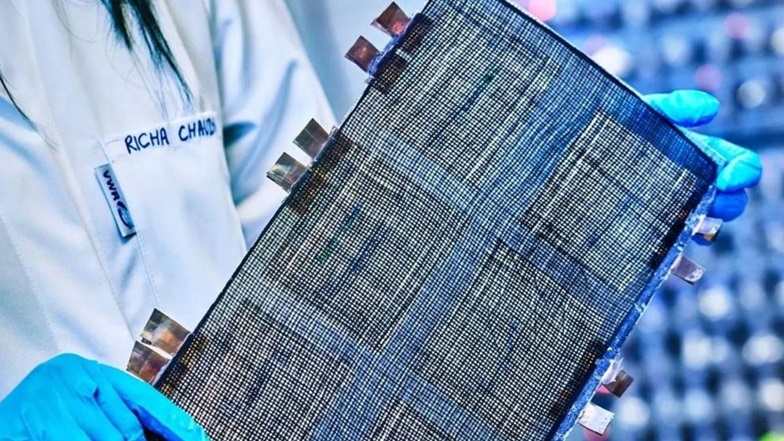The race to create more efficient and durable batteries for electric vehicles (EV) has taken a groundbreaking turn. Researchers at Sweden’s Chalmers University of Technology have unveiled a revolutionary battery design that could redefine energy storage in EVs. By integrating carbon fiber and lithium iron phosphate (LFP), this innovative battery promises to increase EV range by 70% while reducing weight and enhancing safety.

Let’s dive into how this cutting-edge technology works, its potential applications, and what it means for the future of sustainable transportation.
The Game-Changing Battery Design
The Swedish research team has crafted a composite battery that combines functionality, safety, and flexibility. Unlike traditional batteries, this new design incorporates carbon fiber electrodes and lithium iron phosphate for an advanced structure.
Key Features:
- Carbon Fiber Skeleton: Serves as both reinforcement and an electrical conductor, making the battery extremely strong and lightweight.
- Lithium Iron Phosphate Coating: Enhances energy storage capacity and safety.
- Structural Integration: The design allows the battery to be embedded into the vehicle’s body, maximizing space and reducing overall weight.
This innovative structure addresses common challenges in EV batteries, such as overheating and limited durability, while opening new possibilities for vehicle design.
How It Works
In this battery, the carbon fiber plays multiple roles:
- At the Anode: It acts as reinforcement, a current collector, and active material.
- At the Cathode: It provides structural support, acts as a current collector, and scaffolds lithium ions.
This multi-functional approach simplifies the battery’s structure, enhances safety, and boosts its lifespan.
Benefits of Carbon Fiber Batteries
- Extended Range: With the potential to increase EV autonomy by 70%, this battery could significantly reduce range anxiety for EV owners.
- Lighter Weight: By integrating the battery into the vehicle’s structure, the overall weight of the car is substantially reduced, improving efficiency.
- Enhanced Safety: The structural design minimizes the risk of thermal runaway (a phenomenon where batteries overheat and catch fire) and ensures better performance during impacts.
- Versatility: This technology isn’t limited to cars—it could power heavy vehicles like trains and airplanes, creating opportunities in industrial applications.

Challenges Ahead
While the innovation holds immense promise, there are hurdles to overcome before it reaches the market.
Energy Density
Currently, the battery’s energy density is only 30 Wh/kg—far below the 150 Wh/kg offered by commercial LFP batteries. Researchers are optimistic about future improvements, but the technology needs further refinement to compete with existing solutions.
Commercial Viability
Scaling this technology for mass production and ensuring cost-effectiveness will be key challenges. The high cost of carbon fiber materials could limit its affordability for mainstream EVs in the short term.
Carbon Fiber Batteries vs. Traditional EV Batteries
| Feature | Carbon Fiber Battery | Traditional LFP Battery |
|---|---|---|
| Range Increase | Up to 70% | Moderate |
| Energy Density | 30 Wh/kg (currently) | 150 Wh/kg (commercial) |
| Weight Impact | Significantly reduced due to structural role | Standard weight for a standalone unit |
| Safety | Superior thermal and impact resistance | Prone to thermal runaway risks |
| Applications | Cars, heavy vehicles, trains, airplanes | Primarily for EVs |
A Revolutionary Approach to Vehicle Design
One of the standout features of this battery technology is its potential to transform the way vehicles are built. By extending the battery throughout the vehicle’s body, it can utilize unused spaces for energy storage. This integration could lead to sleeker designs and more spacious interiors without compromising on battery capacity.
For industries like aviation and freight, this concept could unlock unprecedented levels of efficiency. Planes and trains, which require large amounts of energy storage, could benefit immensely from the lightweight yet durable properties of carbon fiber batteries.
Broader Implications for the EV Market
This innovation comes at a time when the global push for electrification is intensifying. With governments and automakers seeking solutions to improve EV performance and reduce costs, carbon fiber batteries could provide the breakthrough the industry has been waiting for.
For EV Manufacturers
This technology offers a way to differentiate their vehicles with longer ranges and lighter designs, potentially appealing to a wider audience.
For Consumers
The promise of safer, longer-lasting, and more efficient batteries could make EVs even more attractive, encouraging faster adoption of zero-emission vehicles.
Looking Ahead
Although no release date has been set for these batteries, researchers believe further developments could lead to significant advancements in energy density. With continued innovation, carbon fiber batteries could rival or surpass current LFP options in both efficiency and commercial viability.
As the technology matures, it is likely to become a cornerstone of next-generation EVs, offering a greener, safer, and more sustainable future for transportation.
A Leap Forward in Battery Technology
The carbon fiber battery represents a paradigm shift in energy storage, blending strength, safety, and sustainability. While challenges remain, its potential to extend range, reduce weight, and revolutionize vehicle design cannot be overstated.
As we await further developments, one thing is clear: innovations like these are essential for driving the global transition to electric mobility. With researchers pushing boundaries, the dream of efficient, affordable, and widely accessible EVs is closer than ever.
Related Post
